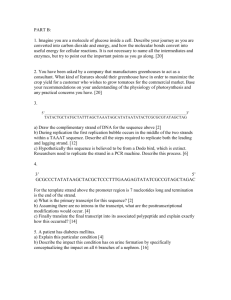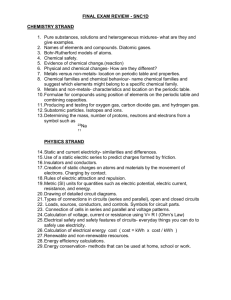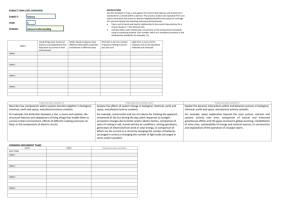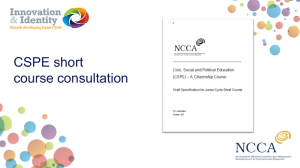Animal Science - Santa Cruz County Regional Occupational Program
advertisement
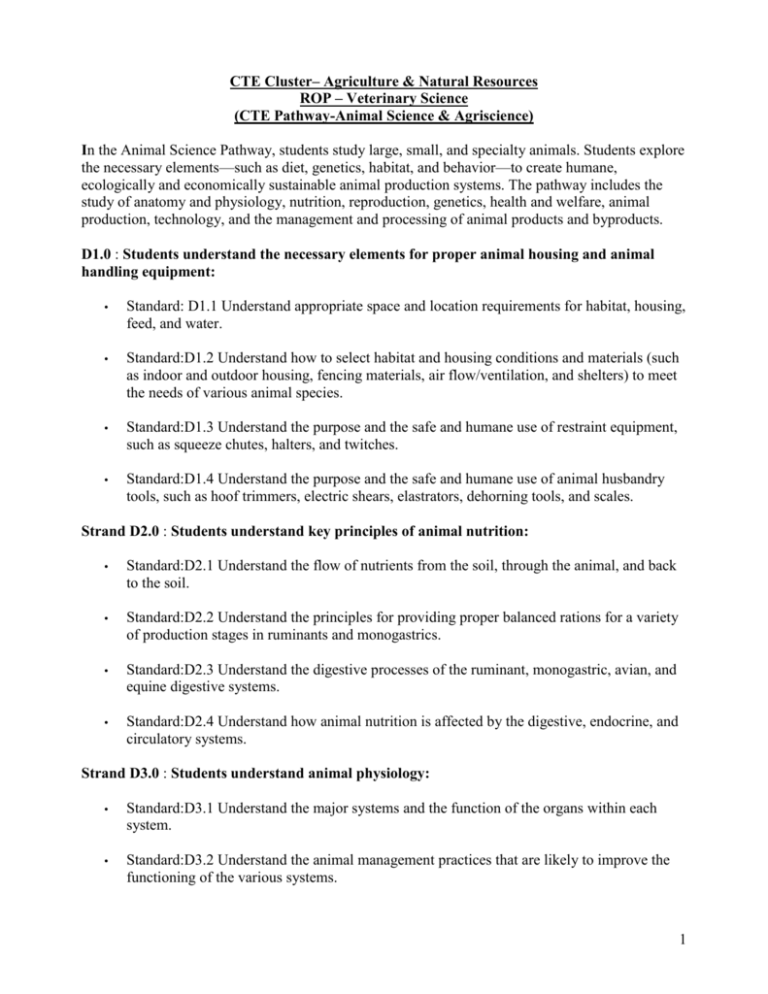
CTE Cluster– Agriculture & Natural Resources ROP – Veterinary Science (CTE Pathway-Animal Science & Agriscience) In the Animal Science Pathway, students study large, small, and specialty animals. Students explore the necessary elements—such as diet, genetics, habitat, and behavior—to create humane, ecologically and economically sustainable animal production systems. The pathway includes the study of anatomy and physiology, nutrition, reproduction, genetics, health and welfare, animal production, technology, and the management and processing of animal products and byproducts. D1.0 : Students understand the necessary elements for proper animal housing and animal handling equipment: Standard: D1.1 Understand appropriate space and location requirements for habitat, housing, feed, and water. Standard:D1.2 Understand how to select habitat and housing conditions and materials (such as indoor and outdoor housing, fencing materials, air flow/ventilation, and shelters) to meet the needs of various animal species. Standard:D1.3 Understand the purpose and the safe and humane use of restraint equipment, such as squeeze chutes, halters, and twitches. Standard:D1.4 Understand the purpose and the safe and humane use of animal husbandry tools, such as hoof trimmers, electric shears, elastrators, dehorning tools, and scales. Strand D2.0 : Students understand key principles of animal nutrition: Standard:D2.1 Understand the flow of nutrients from the soil, through the animal, and back to the soil. Standard:D2.2 Understand the principles for providing proper balanced rations for a variety of production stages in ruminants and monogastrics. Standard:D2.3 Understand the digestive processes of the ruminant, monogastric, avian, and equine digestive systems. Standard:D2.4 Understand how animal nutrition is affected by the digestive, endocrine, and circulatory systems. Strand D3.0 : Students understand animal physiology: Standard:D3.1 Understand the major systems and the function of the organs within each system. Standard:D3.2 Understand the animal management practices that are likely to improve the functioning of the various systems. 1 Strand D4.0 : Students understand animal reproduction, including the function of reproductive organs: Standard:D4.1 Understand animal conception (including estrus cycles, ovulation, and insemination). Standard:D4.2 Understand the gestation process and basic fetal development. Standard:D4.3 Understand the parturition process, including the identification of potential problems and their solutions. Standard:D4.4 Understand the role of artificial insemination and embryo transfer in animal agriculture. Standard:D4.5 Understand commonly used animal production breeding systems (e.g., purebred compared with crossbred) and reasons for their use. Strand D5.0 : Students understand animal inheritance and selection principles, including the structure and role of DNA: Standard:D5.1 Evaluate a group of animals for desired qualities and discern among them for breeding selection. Standard:D5.2 Understand how to use animal performance data in the selection and management of production animals. Standard:D5.3 Research and discuss current technology used to measure desirable traits. Standard:D5.4 Understand how to predict phenotypic and genotypic results of a dominant and recessive gene pair. Standard:D5.5 Understand the role of mutations (both naturally occurring and artificially induced) and hybrids in animal genetics. Strand D6.0 : Students understand the causes and effects of diseases and illnesses in animals: Standard:D6.1 Understand the signs of normal health in contrast to illness and disease. Standard:D6.2 Understand the importance of animal behavior in diagnosing animal sickness and disease. Standard:D6.3 Understand the common pathogens, vectors, and hosts that cause disease in animals. Standard:D6.4 Understand prevention, control, and treatment practices related to pests and parasites. 2 Standard:D6.5 Apply quality assurance practices to the proper administration of medicines and animal handling. Standard:D6.6 Understand how diseases are passed among animal species and from animals to humans and how that relationship affects health and food safety. Standard:D6.7 Understand the impacts on local, national, and global economies as well as to consumers and producers when animal diseases are not appropriately contained and eradicated. Strand D7.0 : Students understand common rangeland management practices and their impact on a balanced ecosystem: Standard:D7.1 Understand the role of rangeland use in an effective animal production program. Standard:D7.2 Know how rangeland management practices affect pasture production, erosion control, and the general balance of the ecosystem Standard:D7.3 Understand how to manage rangelands (including how to calculate carrying capacity) for a variety of animal species and locations. Standard:D7.4 Understand how to balance rangeland use for animal grazing and for wildlife habitat. Strand D8.0 : Students understand the challenges associated with animal waste management: Standard:D8.1 Understand animal waste treatment and disposal management systems. Standard:D8.2 Understand various methods for using animal waste and their environmental impacts Standard:D8.3 Understand the health and safety regulations that are an integral part of properly managed animal waste systems. Strand D9.0 : Students understand animal welfare concerns and management practices that support animal welfare: Standard:D9.1 Know the early warning signs of animal distress and how to rectify them. Standard:D9.2 Understand public concerns for animal welfare in the context of housing, behavior, nutrition, transportation, disposal, and harvest. Standard:D9.3 Understand federal and state animal welfare laws and regulations, such as those for abandoned and neglected animals, animal fighting, euthanasia, and medical research. 3 Standard:D9.4 Understand the regulations for humane transport and harvest of animals, such as those delineated by the U.S. Department of Agriculture, Food Safety and Inspection Service, and the Humane Methods of Slaughter Act. Strand D10.0 : Students understand large animal (cattle, horses, swine, sheep, goats, etc.) and small animal (poultry, cavy, rabbits, etc.) production: Standard:D10.1 Know how to synthesize and implement optimum requirements for diet, genetics, habitat, and behavior in the production of large and small animals. Standard:D10.2 Understand how to develop, maintain, and use growth and management records for large or small animals. Strand D11.0 : Students understand specialty animal (fish, marine animals, llamas, tall flightless birds, etc.) production: Standard:D11.1 Understand the specialty animal’s role in agriculture (e.g., fish farms, pack animals, working dogs). Standard:D11.2 Understand the unique nutrition, health, and habitat requirements for specialty animals. Standard:D11.3 Know how to synthesize and implement optimum requirements for diet, genetics, habitat, and behavior in the production of specialty animals. Standard:D11.4 Understand how to develop, maintain, and use growth and management records for specialty animals. Strand D12.0 : Students understand how animal products and byproducts are processed and marketed: Standard:D12.1 Understand animal harvest, carcass inspection and grading, and meat processing safety regulations and practices and the removal and disposal of nonedible byproducts, such as those outlined in Hazard Analysis and Critical Control Point documents. Standard:D12.2 Understand the relative importance of the major meat classifications, including the per capita consumption and nutritive value of those classifications. Standard:D12.3 Understand how meat-based products and meals are made. Standard:D12.4 Understand how nonmeat products (such as eggs, wool, pelts, hides, and byproducts) are harvested and processed. Standard:D12.5 Understand how meat products and nonmeat products are marketed. Standard:D12.6 Understand the value of animal byproducts to nonagricultural industries. 4 The Agriscience Pathway helps students acquire a broad understanding of a variety of agricultural areas, develop an awareness of the many career opportunities in agriculture, participate in occupationally relevant experiences, and work cooperatively with a group to develop and expand leadership abilities. Students study California agriculture, agricultural business, agricultural technologies, natural resources, and animal, plant, and soil science. C1.0: Students understand the role of agriculture in the California economy: Standard: C1.1 Understand the history of the agricultural industry in California. Standard: C1.2 Understand how California agriculture affects the quality of life. Standard: C1.3 Understand the interrelationship of California agriculture and society at the local, state, national, and international levels. Standard: C1.4 Understand the economic impact of leading California agricultural commodities. Standard: C1.5 Understand the economic impact of major natural resources in California. Standard: C1.6 Know the economic importance of major agricultural exports and imports. C2.0: Students understand the interrelationship between agriculture and the environment: Standard: C2.1 Understand important agricultural environmental impacts on soil, water, and air. Standard: C2.2 Understand current agricultural environmental challenges. Standard: C2.3 Understand how natural resources are used in agriculture. Standard: C2.4 Compare and contrast practices for conserving renewable and nonrenewable resources. Standard: C2.5 Understand how new energy sources are developed from agricultural products (e.g., gas-cogeneration and ethanol). C3.0: Students understand the effects of technology on agriculture: Standard: C3.1 Understand how an agricultural commodity moves from producer to consumer. Standard: C3.2 Understand how technology influences factors such as labor, efficiency, diversity, availability, mechanization, communication, and so forth. 5 Standard: C3.3 Understand public concern for technological advancements in agriculture, such as genetically modified organisms. Standard: C3.4 Understand the laws and regulations concerning biotechnology. C4.0: Students understand the importance of animals, the domestication of animals, and the role of animals in modern society: Standard: C4.1 Understand the evolution and roles of domesticated animals in society. Standard: C4.2 Know the differences between domestication and natural selection. Standard: C4.3 Understand the modern-day uses of animals and animal byproducts. Standard: C4.4 Understand various points of view regarding the use of animals. Standard: C4.5 Understand unique and alternative uses of animals (e.g., Handi-Riders and companion animals). C5.0: Students understand the cell structure and function of plants and animals: Standard: C5.1 Understand the purpose and anatomy of cells. Standard: C5.2 Know how cell parts function. Standard: C5.3 Understand various cell actions, such as osmosis and cell division. Standard: C5.4 Understand how plant and animal cells are alike and different. Strand C6.0: Students understand animal anatomy and systems: Standard: C6.1 Know the names and locations of the external anatomy of animals. Standard: C6.2 Know the anatomy and major functions of vertebrate systems, including digestive, reproductive, circulatory, nervous, muscular, skeletal, respiratory, and endocrine systems. Strand C7.0: Students understand basic animal genetics: Standard: C7.1 Differentiate between genotype and phenotype, and describe how dominant and recessive genes function. Standard: C7.2 Compare genetic characteristics among cattle, sheep, swine, and horse breeds. Standard: C7.3 Understand how to display phenotype and genotype ratios (e.g., by using a Punnett Square). 6 Standard: C7.4 Understand the fertilization process. Standard: C7.5 Understand the purpose and processes of mitosis and meiosis. C8.0 : Students understand fundamental animal nutrition and feeding: Standard: C8.1 Know types of nutrients required by farm animals (e.g., proteins, minerals, vitamins, carbohydrates, fats/oils, and water). Standard: C8.2 Analyze suitable common feed ingredients, including forages, roughages, concentrates, and supplements, for ruminant, monogastric, equine, and avian digestive systems. Standard: C8.3 Understand basic animal feeding guidelines and evaluate sample feeding programs for various species, including space requirements and economic considerations. C9.0: Students understand basic animal health: Standard: C9.1 Assess the appearance and behavior of a normal, healthy animal. Standard: C9.2 Understand the ways in which housing, sanitation, and nutrition influence animal health and behavior. Standard: C9.3 Understand the causes and control of common animal diseases. Standard: C9.4 Understand how to control parasites and why. Standard: C9.5 Understand the legal requirements for the procurement, storage, methods of application, and withdrawal times of animal medications, and know proper equipment handling and disposal techniques. C10.0: Students understand soil science principles: Standard: C10.1 Recognize the major soil components and types. Standard: C10.2 Understand how soil texture, structure, pH, and salinity affect plant growth. Standard: C10.3 Understand water delivery and irrigation system options. Standard: C10.4 Understand the types, uses, and applications of amendments and fertilizers. Strand C11.0: Students understand plant growth and development: Standard: C11.1 Understand the anatomy and functions of plant systems and structures. 7 Standard: C11.2 Understand plant growth requirements. Standard: C11.3 Know annual, biennial, and perennial life cycles Standard: C11.4 Examine plant sexual and asexual reproduction. Standard: C11.5 Understand the photosynthesis process and the roles of the sun, chlorophyll, sugar, oxygen, carbon dioxide, and water in the process. Standard: C11.6 Understand the respiration process in the breakdown of food and organic matter. C12.0: Students understand fundamental pest management Standard: C12.1 Understand the major classifications of pests (e.g., insects, weeds, disease, and vertebrate pests). Standard: C12.2 Understand chemical, mechanical, cultural, and biological methods of plant pest control. Standard: C12.3 Understand the major principles, advantages, and disadvantages of integrated pest management. Strand C13.0: Students understand the scientific method: Standard: C13.1 Understand the steps of the scientific method. Standard: C13.2 Analyze an animal or plant problem and devise a solution based on the scientific method. Standard: C13.3 Use the scientific method to conduct agricultural experiments. 8



